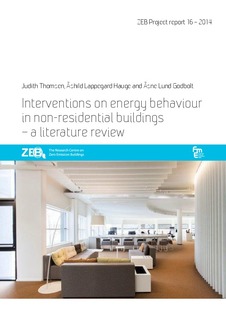| dc.contributor.author | Thomsen, Judith | |
| dc.contributor.author | Hauge, Åshild Lappegard | |
| dc.contributor.author | Godbolt, Åsne Lund | |
| dc.date.accessioned | 2016-02-12T12:47:42Z | |
| dc.date.accessioned | 2016-02-19T07:33:41Z | |
| dc.date.available | 2016-02-12T12:47:42Z | |
| dc.date.available | 2016-02-19T07:33:41Z | |
| dc.date.issued | 2014 | |
| dc.identifier.isbn | 978-82-536-1396-3 | |
| dc.identifier.isbn | 978-82-536-1397-0 | |
| dc.identifier.issn | 1893-157X | |
| dc.identifier.issn | 1893-1561 | |
| dc.identifier.uri | http://hdl.handle.net/11250/2379618 | |
| dc.description.abstract | The aim of this review is to gain an overview of how interventions or experiments as a method are used to detect how to influence employees to use less energy. Most of the interventions on energy behaviour have focused on the residential sector. This literature review focuses on experiments conducted in nonresidential buildings, but also refers to some relevant studies done in the residential sector.
Employees do not have economic motives for saving energy, nor do they usually have the possibility to follow the energy consumption of the building. What type of interventions can motivate them to save energy? What are implications for further research on user behaviour for energy efficiency in nonresidential buildings?
The findings from this review show that possibilities for strategic interventions to influence energy consumption in non-residential buildings are more limited than in households. Interventions should be based on feedback, knowledge, beliefs and norms since the economic dimension available in housing is inaccessible in non-residential buildings. The organizational context has shown to be important in influencing energy related behaviour at a workplace. In order to create a new energy culture and motivation for energy reduction, it is important that the management participates, and that the pro-environmental attitudes pervade the organization.
Giving the employees access to information about the general energy consumption of the building can also motivate changes in energy use.
Further research on energy behaviour in non-residential buildings should adopt an interdisciplinary focus in order to deal with the complexity of energy behaviour. Multiple interventions to test different motivational factors and long-term documentation of effects can be recommended on the basis of the existing studies. The role of attitudes of the management and the organization should also be investigated and documented more thoroughly. | |
| dc.language.iso | eng | |
| dc.publisher | SINTEF Academic Press | |
| dc.relation.ispartofseries | ZEB Project report;16 | |
| dc.subject | Energy efficiency | |
| dc.subject | Intervention | |
| dc.subject | Experiment | |
| dc.subject | User behaviour | |
| dc.subject | Non-residential buildings | |
| dc.title | Interventions on energy behaviour in non-residential buildings – a literature review | |
| dc.type | Research report | |
| dc.date.updated | 2016-02-12T12:47:42Z | |
| dc.description.version | publishedVersion | |
| dc.rights.holder | © 2014 SINTEF Academic Press and Norwegian University of Science and Technology | |
| dc.subject.nsi | VDP::Technology: 500 | |
| dc.identifier.cristin | 1162744 | |
